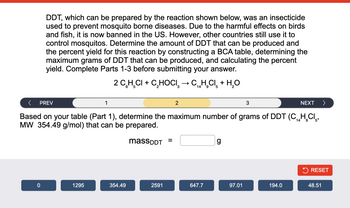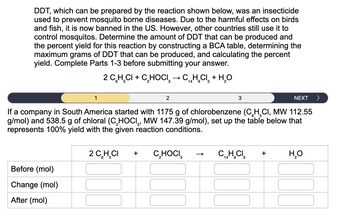
Chemistry
10th Edition
ISBN: 9781305957404
Author: Steven S. Zumdahl, Susan A. Zumdahl, Donald J. DeCoste
Publisher: Cengage Learning
expand_more
expand_more
format_list_bulleted
Concept explainers
Question
thumb_up100%

Transcribed Image Text:DDT, which can be prepared by the reaction shown below, was an insecticide
used to prevent mosquito borne diseases. Due to the harmful effects on birds
and fish, it is now banned in the US. However, other countries still use it to
control mosquitos. Determine the amount of DDT that can be produced and
the percent yield for this reaction by constructing a BCA table, determining the
maximum grams of DDT that can be produced, and calculating the percent
yield. Complete Parts 1-3 before submitting your answer.
PREV
NEXT >
Based on your table (Part 1), determine the maximum number of grams of DDT (C₁4H₂CI,
MW 354.49 g/mol) that can be prepared.
14
9
massDDT =
0
1295
2 C₂H₂CI+ C₂HOCI → C₁H₂Cl₂ + H₂O
3
14 9
2
1
354.49
2591
2
647.7
g
97.01
3
194.0
RESET
48.51

Transcribed Image Text:DDT, which can be prepared by the reaction shown below, was an insecticide
used to prevent mosquito borne diseases. Due to the harmful effects on birds
and fish, it is now banned in the US. However, other countries still use it to
control mosquitos. Determine the amount of DDT that can be produced and
the percent yield for this reaction by constructing a BCA table, determining the
maximum grams of DDT that can be produced, and calculating the percent
yield. Complete Parts 1-3 before submitting your answer.
1
Before (mol)
Change (mol)
After (mol)
2 C₂H₂CI+ C₂HOCI → C₁H₂Cl + H₂O
3
14 9 5
2
3
NEXT >
If a company in South America started with 1175 g of chlorobenzene (CH₂CI, MW 112.55
g/mol) and 538.5 g of chloral (C₂HOCI, MW 147.39 g/mol), set up the table below that
represents 100% yield with the given reaction conditions.
2 C₂H₂CI + C₂HOCI
CH.CI
14
9 5
+ H₂O
Expert Solution
This question has been solved!
Explore an expertly crafted, step-by-step solution for a thorough understanding of key concepts.
This is a popular solution
Trending nowThis is a popular solution!
Step by stepSolved in 4 steps with 3 images

Knowledge Booster
Learn more about
Need a deep-dive on the concept behind this application? Look no further. Learn more about this topic, chemistry and related others by exploring similar questions and additional content below.Similar questions
- Please don't provide handwritten solution ....arrow_forwardA reaction has a theoretical yield of 76.5 grams of a product, and a percent yield of 41.2 %. What is the actual yield (in g) of this product in this reaction?arrow_forwardThe actual yield of one of the reactions in 43.5g. What was theoretical yield in the laboratory if the scientist concluded that % yield of the reaction ended up to be 77%.arrow_forward
- What is the % yield of the reaction? What is the limiting reagent? Show complete calculations for the theoretical and % yield calculations, please. Bromobenzene: 4.5mL Magnesium:1.0g Methyl benzoate:2.5mLarrow_forwardQuestion 25 of 97 Submit DDT was an insecticide used to prevent mosquito borne diseases. Due to the harmful effects on birds and fish, it is now banned in the US. However, other countries still use it to control mosquitos. It can be prepared by the reaction shown below. Determine the amount of DDT that can be produced and the percent yield for this reaction. 2C6H,CI + C2HOCI, – C,4H9CI, + H20 2 3 NEXT If a company in South America started with 1175 g of chlorobenzene (C6H5CI, MW 112.55 g/mol) and 538.5 g of chloral (C2HOCI3, MW 147.39 g/mol), set up the table below that represents 100% yield with the given reaction conditions. 2C6H,CI C2HOCI, C1.H,Cls H2O Before (mol) Change (mol) After (mol) O RESET 3.132 -3.132 3.654 -3.654 7.308 0. + -7.308 10.44 -10.44 MacBook Air F12 II F8 F10 F11 000 F9 20 F3 F7 F4 F5 F6 esc F2 F1 +.arrow_forwardAn excess of sodium carbonate, Na2CO3, in solution is added to a solution containing 17.87 g CaCl2. After performing the experiment, 12.51 g of calcium carbonate, CaCO3, is produced. Calculate the percent yield of this reaction.arrow_forward
- For the following reaction, determine the mass of Sulfur would be needed to obtain 80.0 g of CS2. The percent yield of the reaction is consistently 92%. CH4 (g) + 4S (g) → CS2 (g) + 2H2S (g)arrow_forward2. Ethyl chloride is prepared by the reaction of chlorine with ethane according to the following equation: C:Ho(g) + Cl2(g) – CH$CI(g) + HCl(g) Ethane Ethyl chloride a) Write the balanced chemical equation. Show proof of completion. b) When 5.6 g of ethane is reacted with excess chlorine, determine its theoretical yield c) Calculate the percent yield of ethyl chloride if experimental results indicated that 8.54 g of ethyl chloride had formed.arrow_forwardGIVEN C4H10 (g) + O2(g) → CO2 (g) + H2O (l) - Balance this reaction equation - Calculate the mass of CO2 produced when 10.5 g of C4H10 react with 15.0 g of O2. - What is the experimental yield if the percent yield in one experiment is found to be 75.5%?arrow_forward
- If the theoretical yield of a reaction is 22.6 gg and the actual yield is 19.9 gg , what is the percent yield? Express your answer to three significant figures.arrow_forwardSodium nitrate, manganese (II) sulfate, potassium sulfate, and water is formed from the reaction of sodium nitrite, potassium permanganate, and sulfuric acid. Calculate the actual yield if a percentage yield of 33.01% of sodium nitrate is formed from 47.22 g sodium nitrite, 38.84 g potassium permanganate, and 42.88 g sulfuric acid. Atomic Mass: Na: 22.990 g/mol N: 14.007 g/mol O: 15.999 g/mol Mn: 54.938 g/mol H: 1.008 g/mol S: 32.065 g/mol K: 39.098 g/molarrow_forwardUse this table to answer the following questions below: Before reaction Before reaction Theoretical yield Theoretical yield Actual yield Yes, it is balanced. Other: Is the chemical reaction involved balanced? If not, kindly type the correct balanced equation. Please take note that subscripts cannot be written properly. What is the percentage yield in this experiment? * 96.3% 93.6% CH3OH 32.0 g 1.00 mol 36.9% 63.9% CO Excess Excess CH3COOH 0 0 1.00 mol 60.0 g 57.8 garrow_forward
arrow_back_ios
SEE MORE QUESTIONS
arrow_forward_ios
Recommended textbooks for you
 ChemistryChemistryISBN:9781305957404Author:Steven S. Zumdahl, Susan A. Zumdahl, Donald J. DeCostePublisher:Cengage Learning
ChemistryChemistryISBN:9781305957404Author:Steven S. Zumdahl, Susan A. Zumdahl, Donald J. DeCostePublisher:Cengage Learning ChemistryChemistryISBN:9781259911156Author:Raymond Chang Dr., Jason Overby ProfessorPublisher:McGraw-Hill Education
ChemistryChemistryISBN:9781259911156Author:Raymond Chang Dr., Jason Overby ProfessorPublisher:McGraw-Hill Education Principles of Instrumental AnalysisChemistryISBN:9781305577213Author:Douglas A. Skoog, F. James Holler, Stanley R. CrouchPublisher:Cengage Learning
Principles of Instrumental AnalysisChemistryISBN:9781305577213Author:Douglas A. Skoog, F. James Holler, Stanley R. CrouchPublisher:Cengage Learning Organic ChemistryChemistryISBN:9780078021558Author:Janice Gorzynski Smith Dr.Publisher:McGraw-Hill Education
Organic ChemistryChemistryISBN:9780078021558Author:Janice Gorzynski Smith Dr.Publisher:McGraw-Hill Education Chemistry: Principles and ReactionsChemistryISBN:9781305079373Author:William L. Masterton, Cecile N. HurleyPublisher:Cengage Learning
Chemistry: Principles and ReactionsChemistryISBN:9781305079373Author:William L. Masterton, Cecile N. HurleyPublisher:Cengage Learning Elementary Principles of Chemical Processes, Bind...ChemistryISBN:9781118431221Author:Richard M. Felder, Ronald W. Rousseau, Lisa G. BullardPublisher:WILEY
Elementary Principles of Chemical Processes, Bind...ChemistryISBN:9781118431221Author:Richard M. Felder, Ronald W. Rousseau, Lisa G. BullardPublisher:WILEY

Chemistry
Chemistry
ISBN:9781305957404
Author:Steven S. Zumdahl, Susan A. Zumdahl, Donald J. DeCoste
Publisher:Cengage Learning

Chemistry
Chemistry
ISBN:9781259911156
Author:Raymond Chang Dr., Jason Overby Professor
Publisher:McGraw-Hill Education

Principles of Instrumental Analysis
Chemistry
ISBN:9781305577213
Author:Douglas A. Skoog, F. James Holler, Stanley R. Crouch
Publisher:Cengage Learning

Organic Chemistry
Chemistry
ISBN:9780078021558
Author:Janice Gorzynski Smith Dr.
Publisher:McGraw-Hill Education

Chemistry: Principles and Reactions
Chemistry
ISBN:9781305079373
Author:William L. Masterton, Cecile N. Hurley
Publisher:Cengage Learning

Elementary Principles of Chemical Processes, Bind...
Chemistry
ISBN:9781118431221
Author:Richard M. Felder, Ronald W. Rousseau, Lisa G. Bullard
Publisher:WILEY